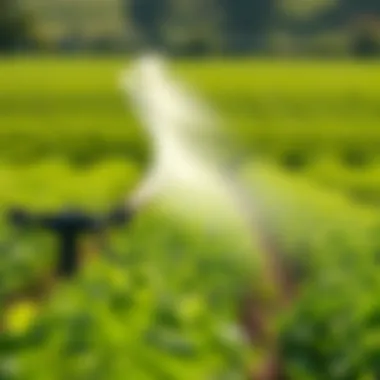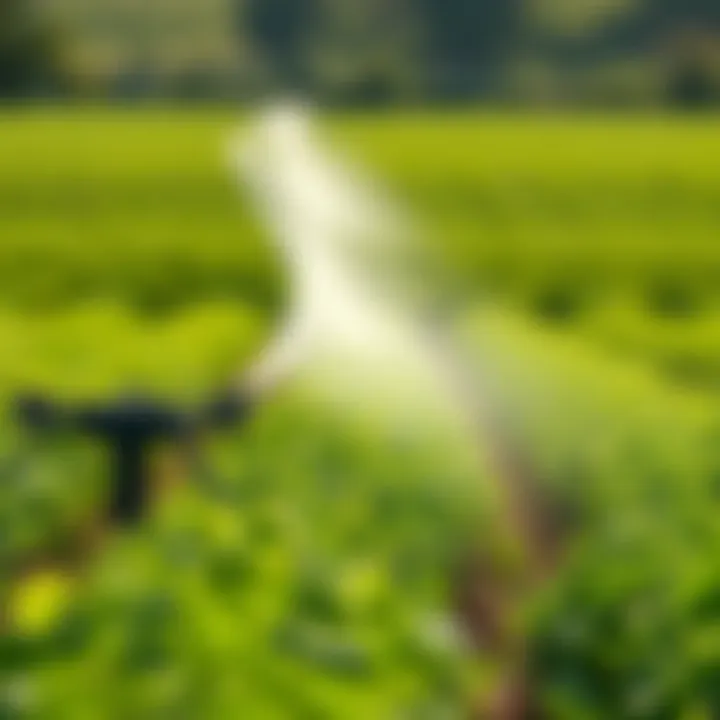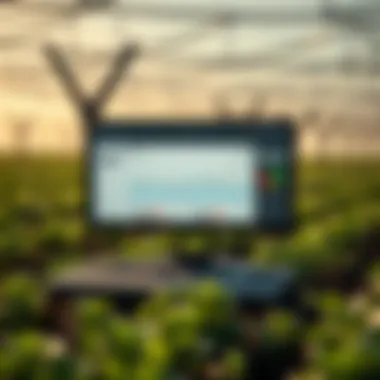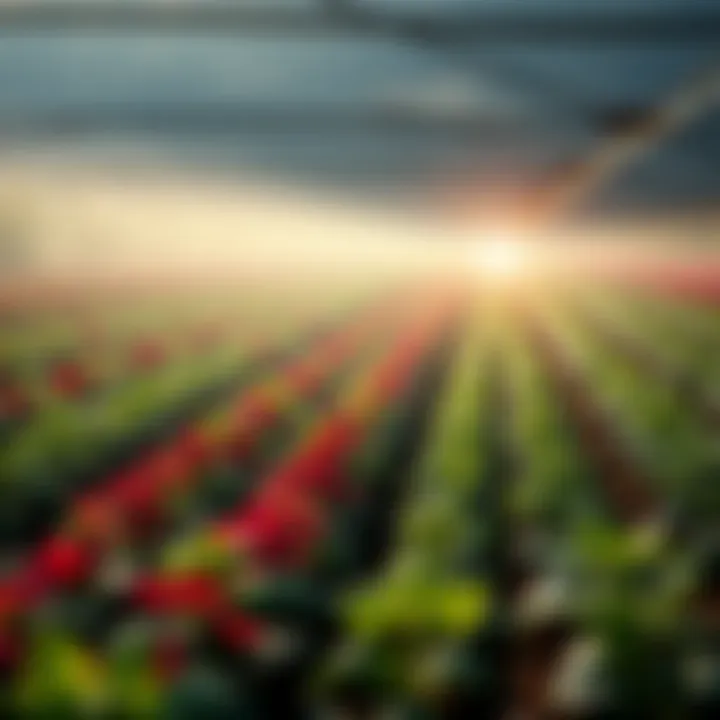Irrigation Scheduling Software Transforming Agriculture


Intro
Irrigation practices are the backbone of agriculture, significantly impacting crop health and yield. As the world grapples with issues like climate change and water scarcity, it becomes crucial for farmers to use every tool at their disposal. That's where irrigation scheduling software comes into play. This technology optimizes water use, ensuring crops receive just the right amount, not a drop more or less. Farmers and enthusiasts alike are discovering that efficient water management is not merely beneficial—it’s essential for sustainability and productivity.
In this article, we will explore the intersection of technology and agriculture. We will cast the spotlight on fresh trends, examine methods that promote sustainability, and share gardening insights that apply to both small- and large-scale operations alike. By breaking down the advantages of irrigation scheduling software, we can help the reader appreciate its role in fostering a greener future, devoid of archaic watering practices.
Through this narrative, we aim to inform agricultural professionals and novices about the intricate details and pivotal significance of these tools.
Latest Trends in Agriculture
Overview of Current Trends
Modern agriculture has seen a substantial shift in practices. One of the most notable trends is the increasing reliance on data-driven decision-making. Farmers are leveraging real-time data to make informed choices about their irrigation needs and crop management.
Moreover, precision farming technologies are emerging. These approaches ensure every inch of farmland is adequately monitored. Drones and IoT devices collect metrics on soil moisture, temperature, and even plant health. This data then flows into irrigation scheduling software, leading to a powerful synergy that maximizes efficiency.
Impact of Technology on Farming Practices
Technology is reshaping not just how farmers water their crops, but how they approach farming overall. Precision agriculture, in particular, minimizes waste.
- Increased Yield: With precise water delivery, farmers often see enhanced crop growth and yield.
- Water Conservation: Software aids in reducing the amount of water used without compromising crop health, an increasingly important factor as climate concerns rise.
- Cost Efficiency: Cutting down water usage translates to lower utility bills and reduced operational costs.
"The best farmers are becoming true data scientists, seamlessly blending traditional practices with cutting-edge technology."
By integrating various technological tools, farmers are dramatically improving their methods. The push toward data and automation is not only revolutionary but necessary.
Sustainable Practices: Towards a Greener Future
Importance of Sustainability in Agriculture
Sustainability is not just a buzzword; it's a pressing requirement. Today, farmers must navigate consumer demands for ethically sourced food while being stewards of the environment. Irrigation scheduling software plays a crucial role in this quest for sustainability.
Why is it so critical? Water scarcity is intensifying pressures on agricultural sectors. So, the required vigilant management of this resource makes it invaluable for every farmer seeking longevity in their practice.
Methods for Sustainable Farming
Several practices can be embraced alongside irrigation scheduling software to cultivate a more sustainable approach:
- Crop Rotation: Preventing soil depletion and controlling pests more effectively.
- Conservation Tillage: Minimizing soil disruption leads to improved moisture retention.
- Utilizing Rainwater Harvesting: Complementing irrigation systems with collected rainwater can ease the demand on groundwater.
- Integrating Cover Crops: Enhancing soil health while preventing erosion.
These techniques cultivate resilience against environmental changes that could otherwise threaten yields.
Gardening Techniques and Tips
Essential Gardening Tools and Equipment
For enthusiasts stepping into the world of gardening, having the right tools is vital. Here’s a quick list of essentials worth having:
- Soil moisture sensor: Monitor water levels directly.
- Trowels and spades: For digging and planting in various soil types.
- Pruning shears: Keeping plants healthy by removing dead or diseased growth.
- Irrigation systems: Drip or sprinklers designed for efficiency.
Seasonal Gardening Practices
Each season brings its own set of challenges and opportunities:
- Spring: Ideal for planting most vegetables and flowers. Incorporate irrigation scheduling to ensure young plants get adequate moisture.
- Summer: Monitor heat stress in plants, adjust water levels accordingly.
- Fall: Time to prepare gardens for winter. Consider cover crops to help retain soil moisture through colder months.
- Winter: For the dedicated gardener, plan and outline the next year’s planting schedule based on insights gained over the previous seasons.
This depth of understanding surrounding gardening practices allows even novice enthusiasts to cultivate a thriving garden through conscious water management.
Foreword to Irrigation Scheduling Software
Irrigation scheduling software is becoming an essential tool for the modern farmer, serving as a cornerstone for effective water management in agriculture. With increasing pressures on water resources and the growing demand for food production, efficient irrigation is crucial. Utilizing technology in this area not only maximizes productivity but also promotes sustainable practices. In this section, we will uncover the various aspects of irrigation scheduling software, emphasizing its benefits, considerations, and relevance.
Understanding Irrigation Scheduling
At its core, irrigation scheduling involves determining the optimal times and amounts of water to apply to crops. This process can make all the difference between a flourishing crop and one that underperforms due to over or under-watering. Software solutions take the guesswork out of scheduling by providing data-driven insights. By integrating information from soil moisture sensors, weather forecasts, and historical crop performance, farmers can make informed decisions tailored to their specific needs. This reduces inefficiencies that can cost time, money, and resources.
Key aspects of understanding irrigation scheduling include:
- Soil moisture levels: Constantly monitor how much water is in the soil to know when and how much to irrigate.
- Crop needs: Different crops have varying water requirements, so it’s essential to customize schedules accordingly.
- Weather conditions: Understanding how rainfall and temperatures affect soil and plant moisture is vital in creating an effective strategy.
This software is not just a luxury or novelty. In a world where every drop of water counts, such tools can lead to significant differences. Much like a well-timed shot in basketball, irrigation must be executed precisely to reap maximum rewards.
Importance of Efficient Water Management
Water is a precious commodity, and its management is paramount in today’s agricultural landscape. Efficient water usage directly influences both the sustainability of farming practices and the environmental impact of agricultural activities. By employing irrigation scheduling software, farmers can achieve several critical outcomes that support efficient water management:


- Resource Conservation: Utilizing software helps minimize water waste, ensuring that every gallon serves its purpose, directly translating to less strain on local water supplies.
- Economic Benefits: Reduced water usage leads to lower irrigation costs, ultimately boosting profit margins. The financial implications cannot be overstated, especially for small-scale farmers.
- Environmental Sustainability: By adopting efficient irrigation practices, farmers contribute to preserving local ecosystems, reducing runoff, and mitigating the effects of drought.
Efficient irrigation is no longer merely a good practice, but a necessity for sustainable agriculture.
Key Features of Irrigation Scheduling Software
Irrigation scheduling software has transformed how farmers approach water management, offering specialized tools that streamline processes for both efficiency and effectiveness. The features of these systems play a critical role in enhancing agricultural practices, making it essential for users to understand exactly what to look for. Incorporating these key features not only ensures maximum water conservation but also promotes optimal crop growth, addressing a fundamental need in modern agriculture.
Data Integration and Sensors
A notable aspect of irrigation scheduling software is its ability to integrate various data sources, especially soil sensors and weather feeds. By collecting real-time data, farmers can make informed decisions regarding water application. Sensors can monitor soil moisture, salinity, and temperature, providing insights that help tailor irrigation schedules precisely to the crops' needs.
For instance, a farmer in California may utilize soil moisture sensors to determine when to irrigate their citrus orchards. With this data, they can avoid both over-watering and under-watering, promoting healthier trees and preventing waste. The integration of these technologies can reduce water usage significantly. The effectiveness of these strategies often leads to reduced costs and improved yields, showcasing how data-driven decisions can reshape agricultural outcomes.
User-Friendly Interface
Navigating technology shouldn't feel like cracking a secret code. The value of a user-friendly interface in irrigation scheduling software cannot be overstated. Software that is easy to navigate reduces training times and minimizes frustration, allowing farmers to focus on what they do best: cultivating crops.
Without getting lost in a maze of buttons and menus, users can quickly access and manipulate data. Simple graphics, intuitive dashboards, and straightforward reporting tools empower users to analyze their irrigation needs on-the-fly. For example, an organic farmer might want to rapidly adjust their irrigation plans due to sudden weather changes. A clean interface allows them to do so with a few taps on their screen, ensuring their operations remain smooth and responsive.
"The easier it is to use the software, the more likely farmers will adapt and take full advantage of what it offers."
Many of these platforms now include mobile applications, further enhancing accessibility. Being able to track moisture levels or adjust irrigation schedules from a smartphone while out in the field adds a layer of convenience that supports timely interventions.
Customizable Irrigation Plans
Every farm is different, much like every farmer’s approach to irrigation. Hence, customizable irrigation plans are a key feature in any effective irrigation scheduling software. These tools allow farmers to tailor schedules based on crop type, growth stage, and local climate conditions.
For instance, a vineyard owner may craft specific schedules based on the water needs of different grape varieties, while also accounting for seasonal weather patterns. By adapting the irrigation plan, they can enhance water use efficiencies and maximize fruit quality.
Customizability also extends to setting alerts and notifications. A user can program software to send reminders about when to irrigate or update them when soil moisture reaches a critical level. This ensures that farmers aren't caught off guard, making their operations more proactive rather than reactive.
In summary, software that offers these adaptable capabilities supports a more hands-on approach to water management, ultimately leading to better sustainability practices in agriculture.
As farmers embrace modern technology, understanding these key features becomes invaluable, paving the way for a more efficient and effective agricultural future.
Types of Irrigation Scheduling Software
Understanding the various types of irrigation scheduling software is essential for modern agriculture. It's like having the right tools in a toolbox; knowing which one to grab can save time, effort, and resources. Each type has its unique advantages and specific uses, which can significantly influence farming practices and crop yields.
Cloud-Based Solutions
Cloud-based irrigation scheduling software have gained a lot of traction in recent years. This kind of software operates over the Internet, allowing farmers to access their irrigation data anytime, anywhere. Think of it as having your farm's brain in your pocket. This flexibility means you don’t have to stand around the equipment or be in front of a computer to monitor moisture levels or adjust settings.
- Accessibility: With cloud solutions, farmers can easily share data with agronomists or management teams. This fosters collaboration and enhances decision-making.
- Real-Time Updates: These solutions are often connected to sensors that provide real-time data. That way, if a sudden rainstorm occurs, the system can adjust automatically, saving water.
- Scalability: As farms grow, cloud solutions can adapt without requiring significant additional investments in equipment. Farmers can simply scale up their usage or add new features as needed.
Cloud-based solutions often integrate seamlessly with other technologies, making them versatile and future-proof. If you think about it, having the world at your fingertips is quite a game-changer in agriculture.
On-Premises Software
On-premises software is a different kettle of fish. This type involves installing programs directly onto a farmer's local hardware, usually a computer or server. While it might seem outdated in a world driven by cloud solutions, there are specific scenarios where on-premises software shines.
- Control: Many farmers prefer to keep sensitive data on local servers, ensuring extra security from external threats. Control over data can be crucial, especially when regulations and compliance come into play.
- Customization: On-premises software can often be tailored to meet very specific farming needs. Unlike some cloud solutions that may offer rigid templates, on-premises options can accommodate unique workflows and preferences.
- Reliability: In areas where internet connectivity is flaky or unreliable, having software that runs on local machines can prevent interruptions and ensure consistent performance.
While on-premises solutions might come with higher upfront setup costs, they are a solid choice for farms with distinct operational needs.
Mobile Applications
Mobile applications have completely changed the game for irrigation scheduling. In an age where everyone is glued to their smartphones, having a dedicated app means farmers can manage their irrigation from the palm of their hand. Rather than waiting until they return to the field or office, they can make swift adjustments on the go.
- Portability: Farmers are often on the move, checking fields or attending to various tasks. Mobile apps allow them to receive updates and modifications, whether they are in the tractor or sipping coffee at the diner down the road.
- User Experience: Many mobile applications prioritize user-friendly interfaces, making them accessible even to those who aren’t tech-savvy. With simple dashboards and visuals, understanding irrigation schedules and moisture levels becomes less daunting.
- Alerts and Notifications: Mobile applications can send push notifications, reminding farmers when to irrigate or alerting them of any anomalies in real time. This proactive approach can mitigate issues before they escalate into problems.
In summary, the landscape of irrigation scheduling software is as dynamic as the agriculture it serves. Each type offers unique strengths that cater to different operational needs. Knowing when and how to utilize these options can propel any farming operation into a realm of efficiency and productivity that traditional methods may lack.
Benefits of Using Irrigation Scheduling Software
Irrigation scheduling software has become a cornerstone in modern farming practices. Its significance cannot be understated, as it directly impacts the efficiency of water use, crop health, and, ultimately, agricultural productivity. With every drop of water being precious, managing irrigation effectively becomes crucial in today’s agricultural landscape. Here are some key advantages this kind of software brings to the table:
Improved Water Conservation
One of the standout features of irrigation scheduling software is its capability to enhance water conservation. Farmers often struggle to determine when to water their crops. Irrigation software utilizes various data sources, such as soil moisture levels and weather forecasts, to inform watering schedules. This ensures that crops receive the right amount of water at the right time.
By adopting this tech, farmers can reduce oversaturation, which not only saves water but also prevents nutrient runoff. The result is a more sustainable approach that aligns with environmental stewardship and agricultural efficiency. Moreover, even small adjustments in irrigation practices can lead to substantial water savings, especially in dry regions. In short, using irrigation scheduling software fosters a mindset of careful water management that can lead to healthier ecosystems.
Enhanced Crop Yields
Another primary benefit of utilizing irrigation scheduling software is the enhancement of crop yields. Consistent and appropriate watering leads to robust plant development. The software analyzes plant needs through data collection methods, thus helping farmers respond dynamically to their crops' requirements. For instance, if weather conditions shift unexpectedly, farmers can make timely decisions to either increase or decrease irrigation based on real-time data.


When crops receive optimal water resources, they are less stressed and more productive. This translates to larger harvests and improved quality, offering a significant return on investment. Ultimately, the software acts as both a hydrologist and a farmer’s assistant, optimizing yields while keeping resource management in check.
Time and Labor Efficiency
Irrigation scheduling software can also lead to significant time and labor efficiencies. Traditionally, farmers would spend countless hours planning and executing their irrigation strategies manually. The introduction of automation via software application reduces the time spent on these tasks tremendously.
Farmers can set schedules that ensure their systems run automatically, freeing them up for other crucial tasks on the farm. Moreover, the data provided allows them to make informed decisions quickly, leading to less trial and error, and reducing the workload on seasonal laborers.
In essence, this software isn’t just about irrigation—it’s about enabling farmers to manage their time more effectively, ultimately leading to a smoother operation. A well-implemented scheduling system thus moves them a step closer to achieving their operational goals.
"The right tools can transform a farmer's approach to irrigation. Software that improves water conservation, enhances yields, and increases efficiency is a game-changer."
As on-the-ground needs continue to evolve, understanding these benefits highlights the power of irrigation scheduling software. It’s not just a tool, but rather an essential investment in sustainable farming practices.
Challenges in Implementing Irrigation Scheduling Software
Implementing irrigation scheduling software can be a bit like trying to navigate uncharted waters. Sure, the potential for greater efficiency and sustainability is enticing, but there are also a host of challenges that can make the journey difficult. Recognizing these obstacles is crucial for farmers and agricultural enthusiasts. Understanding these pain points helps to prepare for successful integration into existing operations. Armchair analysis is one thing, but facing the realities of setup, operation, and maintenance is a whole different ballgame.
Initial Setup Costs
First off, let’s talk about the elephant in the room: initial setup costs. Farmers often find themselves caught in a bind. On one hand, investing in modern technology like irrigation scheduling software promises saving on water and labor costs in the long run. On the other hand, the initial financial outlay can be daunting. Typically, the cost includes software licenses, hardware such as sensors, and installation services.
For instance, many farmers might spend thousands on devices and forget about the accompanying costs for training and maintenance. This doesn’t just cover the shiny new gadgets; it’s looking at the price of a complete overhaul of physical and digital infrastructure. By planning ahead, one can cushion the blow and maybe even snag some financial assistance from various government programs aimed at fostering sustainable agriculture.
Technical Barriers to Adoption
Next, there's the issue of technical barriers to adoption. Not every farmer has a tech background, and this can present a significant hurdle. When faced with a complicated new interface or an array of unfamiliar settings, many might feel like they’ve bitten off more than they can chew. Software solutions range in complexity; some offer user-friendly experiences, while others resemble rocket science.
Compatibility with existing systems adds another layer of complexity. If a farmer has already been using a rudimentary spray irrigation method for ages, the thought of switching to a software-based scheduling could feel overwhelming. Furthermore, there’s the risk of device malfunctions or misreading data, leaving farmers back at square one. Creating a plan for technical support can help simplify these transition pains. Having reliable tech support can be like having a trusty compass in a storm.
Training Requirements
Lastly- but certainly not least- are the training requirements. Even if the software is intuitive, a lack of training can render the most advanced tools ineffective. Failure to provide adequate training could result in misuse or underutilization. After all the hustle and bustle of installation, the tools need to be understood to serve their purpose. Internal training sessions can get everyone on the same page and increase overall confidence in using the new software.
In practice, solutions might involve hiring an expert for onboarding or creating manuals and video guides tailored to the specific needs of the farm. Investing time in training upfront pays off when incorrect settings avoid costly mistakes down the road. After all, no one wants to find out the hard way that they’ve been watering the wrong field!
"Investing in ideal training is like watering a seed; nurturing initial understanding leads to prosperous outcomes down the line."
As these challenges illustrate, the road to successful implementation of irrigation scheduling software isn’t a smooth one. However, tackling these obstacles head-on can pave the way for improved water management and, ultimately, a thriving agricultural operation. By preparing for these issues, the journey into modern irrigation practices can become far less daunting.
Selecting the Right Irrigation Scheduling Software
Choosing the right irrigation scheduling software can make or break a farming operation. It's not just about picking a name out of a hat; it’s about enhancing productivity, conserving water, and ensuring sustainable growth. Each farm has its unique requirements, and the software should tailor itself to those specific needs. Wrong choices can lead to wasted resources or inefficient operation, undermining the very goals that such tools are designed to achieve.
Assessing Your Needs
Before diving into the sea of options available, it’s crucial to take a step back and assess what exactly you need from the software. This involves understanding your specific crops, soil types, and environmental conditions. Consider factors like:
- Crop Water Requirements: Different crops have distinct water needs. Knowing these can help you pick software that can tailor irrigation schedules effectively.
- Soil Characteristics: Soil type influences how water is absorbed and used. Your software choice should accommodate this variability, optimizing water usage based on these parameters.
- Management Style: Are you looking for a hands-on approach, or do you prefer automation? The software should align with your management preferences and operational workflow.
- Budget Constraints: Clearly define your budget for the software. Some solutions might be feature-rich but come with a steep price tag, while others are more modest but still get the job done efficiently.
By thoroughly assessing these elements, you position yourself to make a more informed decision a nd choose a tool that truly works for you.
Comparative Analysis of Available Options
Once you’re clear on your needs, it's time to take a good look at the available options. Not all irrigation scheduling software is created equal, and a comparative analysis can uncover which solutions shine in certain areas. Here’s what to consider during your comparison:
- Features vs. Needs: Make a list of must-have features, such as real-time monitoring or data analytics. Compare these against each software's offerings. If a tool boasts a ton of features but doesn't cater to your specific requirements, it may be less beneficial.
- User Experience: Consider the learning curve of each option. Solutions that are intuitive might save time when training staff or transitioning. A complex interface may hinder productivity instead of enhancing it.
- Integration Capabilities: Check how the software integrates with other tools or platforms you are using, such as accounting software or weather forecast systems. Compatibility can streamline operations and enhance utility.
- Cost-Benefit Ratio: Weigh the cost against the benefits you'll gain. Analyze user testimonials for insights on whether the software delivers on its promises.
Taking the time for a side-by-side comparison ensures you’re not just buying into marketing hype but choosing a genuinely beneficial solution.
Reading User Reviews and Case Studies
User reviews and case studies provide a valuable lens through which to evaluate potential software. They often reveal practical knowledge about how the software performs in real-life conditions.
- Genuine User Experience: Look for feedback from other farmers or agricultural professionals who have used the solutions you’re considering. Forums like Reddit or agricultural communities can be great for finding real stories.
- Success Stories: Often, software providers will showcase case studies that highlight successful implementations. While these can be biased, they may still offer insights into how the software has been a game-changer for others, including less common uses that you might not have considered.
- Potential Drawbacks: Pay attention to negative reviews as they can expose gaps in the software that might affect your operations. If specific issues come up frequently across reviews, it might be worth reconsidering that particular option.
By delving into user experiences, you gain a clearer picture of the software's potential effectiveness and a more well-rounded understanding of its strengths and weaknesses.
"The right irrigation scheduling software can not only save water but also enhance crop yields, making it a tool of choice for any serious farmer."
Taking all these aspects into account while selecting your irrigation scheduling software sets up a foundation for success, leading to better resource management and sustainable farming practices.
Integration with Other Agricultural Technologies
In the rapidly evolving agricultural landscape, integrating irrigation scheduling software with other agricultural technologies is essential. This isn't just about boosting efficiency; it's about creating a cohesive ecosystem that enhances crop productivity while conserving resources. The synergy between different technologies allows for a more comprehensive approach to farming, resulting in better outcomes for both the environment and agricultural productivity.


Linking Soil Moisture Sensors
The role of soil moisture sensors cannot be overstated in the irrigation scheduling narrative. These devices play a fundamental role in data collection, enabling farmers to understand the water needs of their soil in real-time. By integrating soil moisture sensors with irrigation scheduling software, farmers gain a significant edge in their operations.
- Data-Driven Decisions: With accurate moisture readings, farmers can adjust their irrigation schedules based on actual soil conditions rather than relying on estimates. This results in precise watering applications tailored to crop needs, optimizing water usage.
- Preventing Over-Irrigation: On many farms, over-watering plants leads to diminished yields and wasted resources. The link between moisture sensors and scheduling software can mitigate this issue. Farmers can receive alerts when moisture levels are adequate, ensuring that irrigation is only applied when necessary.
- Installation Considerations: While the integration benefits are apparent, installing soil moisture sensors can be tricky. It's vital to place sensors in representative areas within a field to get a true average moisture reading. Choosing the appropriate sensor type—be it capacitive, resistive, or volumetric—can also greatly affect results.
Compatibility with Weather Forecast Systems
The integration of irrigation scheduling software with weather forecast systems stands as another pillar to maximizing the efficiency of agricultural practices. Farming decisions made without considering weather patterns can lead to unnecessary costs or crop damage.
- Forecast Precautions: Weather forecasts can predict rainfall, humidity levels, and temperature fluctuations. By pairing irrigation scheduling software with reliable weather data, farmers can prevent irrigating just before a predicted rainstorm, thereby conserving water and avoiding crop over-saturation.
- Dynamic Irrigation Plans: With real-time weather data, farmers can dynamically adjust their irrigation plans. For example, if a hot, dry spell is on the horizon, the software can prompt users to increase watering regimes accordingly.
- Planning for Pests and Diseases: Weather patterns can also indicate potential pest outbreaks or plant diseases. For instance, more humidity may suggest a higher risk of fungal infections in crops, prompting farmers to modify not just irrigation schedules but also their treatment approaches.
Overall, integrating soil moisture sensors and weather prediction systems with irrigation scheduling software sets the stage for a more intelligent agricultural endeavor. By leveraging these technologies, farmers can make smarter, data-driven decisions that lead to healthier crops and sustainable farming practices.
“In agriculture, the fusion of technology isn't just efficient; it’s essential for survival in an increasingly unpredictable world.”
As we delve deeper into the implications of these integrations, it becomes clear that the future of agriculture will be defined by how well we adapt and integrate these emerging technologies.
Case Studies and Real-World Applications
In the landscape of agriculture, where every drop of water can be as vital as the seeds sown, real-world applications of irrigation scheduling software serve not just as testimonies but also as critical lessons. The integration of technology in water management has reshaped how farmers approach irrigation, optimizing water use while adapting to ever-changing climatic conditions. Here, we’ll explore how these advancements not only solve common agricultural problems but also foster resilience among farmers.
Success Stories in Agriculture
An abundant variety of success stories across the globe underline the effectiveness of irrigation scheduling software in agriculture. For instance, a notable case is the Bayer Crop Science's initiative in California, where the deployment of their irrigation software led to astonishing results. By using soil moisture measurement and climate data integrated into their scheduling tool, farmers were able to enhance water efficiency by a staggering 30%. This significant reduction in water usage did not just save resources; it also Fostered healthier crops and increased yields across their farms.
- Benefits seen by Waldron Farms in Minnesota:
- Yield Increase: Crop yields grew by up to 15% due to precise watering schedules.
- Cost Efficiency: Water bills dropped, reflecting the careful calibration enabled by the software.
Such stories are increasingly critical as they demonstrate tangible benefits. Farmers who adapt these technologies not only improve their immediate crop outcomes but also ensure the longevity and environmental sustainability of their practices.
Application in Horticulture
Horticulture, with its diverse range of crops, stands to gain immensely from irrigation scheduling software. A compelling example is seen with Pine Valley Orchards in Washington. By implementing a user-friendly app that allows them to adjust watering schedules based on real-time weather data, they can manage their irrigation with much greater precision. This means they can respond to unexpected weather patterns, such as sudden rain, without wasting water on already saturated plants.
- Key outcomes include:
- Water Savings: A reduction in water expenditure by around 25%.
- Crop Quality: Fruits and vegetables exhibit improved quality and shelf-life due to optimized watering conditions.
Moreover, the ability to customize watering according to the particular needs of various plants has allowed producers to maximize productivity while being conscientious stewards of water resources. As these applications grow in relevance, the horticultural sector can look forward to a future where efficiency is seamlessly intertwined with sustainability.
"The application of smart irrigation solutions not only optimizes yield quantity but also elevates quality, emphasizing a sustainable approach to farming and horticulture across our landscapes."
In short, these case studies reveal the striking impact that effective irrigation scheduling can bring, transforming traditional farming practices into modern, data-driven strategies that benefit both farmers and the environment.
Future Trends in Irrigation Scheduling Software
The realm of agricultural technology is constantly evolving, and irrigation scheduling software is no exception. As farmers face the pressures of climate change, water scarcity, and the endless demand for food production, embracing innovative technologies becomes crucial. By keeping an eye on future trends in irrigation scheduling, stakeholders can enhance their approach to resource management and crop yield.
Advancements in Artificial Intelligence
Artificial Intelligence, or AI, is paving new paths in the way irrigation scheduling software is engineered and utilized. With predictive analytics, AI can process vast amounts of data almost instantly, helping farmers make informed decisions regarding when and how much to irrigate. This means that instead of relying solely on historical data or basic weather patterns, advanced algorithms can factor in real-time conditions like soil moisture and evaporation rates.
For instance, imagine a farmer in California using AI-powered software that integrates data from multiple weather stations, drone imagery, and soil sensors. This system analyzes the needs of each crop type and updates irrigation schedules accordingly. Not only does this minimize water wastage, but it allows for optimal growth conditions, resulting in healthier plants and eventually higher yields.
The potential for AI to continually learn from outcomes makes it an invaluable ally for modern farmers seeking efficiency.
Sustainability and Environmental Considerations
In today's world, sustainability is not just a buzzword; it is a necessity. As concerns about resource depletion grow, the focus on sustainable agriculture becomes paramount. Irrigation scheduling software can directly contribute to this cause. It helps farmers optimize water use, which is vital for conservation efforts. Efficient irrigation reduces runoff, minimizes soil erosion, and protects local ecosystems.
- By adjusting irrigation times to align with weather forecasts, farmers can anticipate rain events and turn off irrigation systems to prevent water waste.
- Many software solutions now feature water recycling guidance, advising on how to repurpose farm runoff for irrigation. This approach not only conserves water but also reduces the overall operational costs.
- By adopting these sustainable practices, farms can mitigate their environmental impact while also meeting consumer demands for eco-friendly produce.
Ultimately, the culmination of AI advancements and sustainable practices positions irrigation scheduling software as a driving force in reshaping modern agriculture for the better. Farmers who invest in this technology not only stand to gain competitive advantages but also contribute to a healthier planet.
"Incorporating future trends in irrigation scheduling is not just about technology; it's about responsibility towards the environment and future generations."
The End
The conclusion of this article encapsulates the pivotal elements surrounding irrigation scheduling software, emphasizing its significance in modern agricultural practices. As we have explored throughout the article, the integration of technology in water management is not merely advantageous but essential for sustainable farming.
Summarizing Key Insights
In summary, the benefits derived from utilizing irrigation scheduling software are numerous and impactful. Here are some key insights:
- Efficiency in Water Usage: Proper scheduling leads to significant water savings, which is crucial as global water scarcity intensifies.
- Increased Crop Yield: With precise irrigation plans, crops receive optimal hydration, enhancing growth rates and overall yield.
- User-Centric Design: Modern software is increasingly intuitive, making it easier for farmers of all technical backgrounds to adopt and utilize effectively.
- Data-Driven Decisions: The incorporation of real-time data allows farmers to make informed choices, adjusting their irrigation strategies based on soil moisture, weather, and crop needs.
"In a world where every drop counts, irrigation scheduling software stands as a beacon for responsible resource management in agriculture."
Encouraging Adoption for Sustainable Practices
Encouraging the adoption of irrigation scheduling software is crucial for advancing sustainable practices in agriculture. With several barriers still present, including initial costs and technical fears, it’s imperative that stakeholders within the agricultural community promote awareness and provide training.
- Education and Training: Farmers need access to resources that simplify the understanding and implementation of these technologies.
- Government Incentives: Policymakers could play a critical role in fostering adoption by offering subsidies or incentives for farmers who implement efficient irrigation solutions.
- Community Engagement: Sharing success stories and case studies can inspire neighboring farmers to explore these solutions, fostering a collective move towards sustainable agriculture.
By promoting these tools and integrating them into standard farming practices, we can steer the agricultural sector toward a more environmentally friendly and efficient future.







